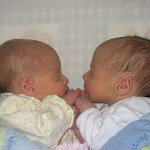Microbiology

Cloning is not a human invention; nature has been creating clones for millions of years, among all organisms including humans. Nature’s clones, identical twins, are born in approximately 1 / 1000 births. Identical twins come in two varieties: identical and mirror images. Both share 100% of their DNA and but in mirror image twins, small differences are ‘reflected’. Examples include skin variations such moles, dental patterns, hairlines and handedness.
The development of a truly identical twins versus mirror image twins comes down to timing. A single sperm will fertilize a single egg and begins…

The enzyme TPPII may contribute to obesity by stimulating the formation of fat cells, suggests a study in EMBO reports this week. The enzyme, TPPII, has previously been linked to making people feel hungry, but Jonathan Graff and colleagues now show that it may be even more deeply involved in causing obesity.
The team found that TPPII actually stimulated the formation of fat cells in worms and mammalian cells and that by reducing it, fat stores decreased. Mice with lower levels of TPPII were thinner than their wild type littermates, although their food intake was comparable.
The authors hope…

Using a molecular cellular compass, individual cells in complex organisms know which way is up or down, in epithelial cells known as apical-basal polarity. Determining the orientation is essential for an individual cell to perform it’s designated tasks.
Now it appears that the same compass also defines the direction of cells when migrating by establishing a morphological back and a front. These are the conclusions of a recent study lead by scientists Michiel Pegtel and John Collard from the Netherlands Cancer Institute - Antoni van Leeuwenhoek Hospital (NKI-AVL) in the Netherlands published…

A human embryonic stem cell is reined in – prevented from giving up its unique characteristics of self-renewal and pluripotency – by the presence of a protein modification that stifles any genes that would prematurely instruct the cell to develop into heart or other specialized tissue. But, thanks to the simultaneous presence of different protein modifications, stem cells are primed and poised, ready to develop into specialized body tissue, Singapore scientists report.
The molecules central to this balancing act, H3K4me3 and H3K27me3, are among the so-called epigenetic modifications that…

Urologists at Thomas Jefferson University Hospital are studying whether a neo-bladder construct grown from a patient’s own cells can improve bladder function for adult spinal cord injury patients.
Jefferson is only one of six sites in the U.S. enrolling participants in this clinical trial for the lab-grown neo-bladder construct that will involve a total of 10 patients.
“It’s never been done in adults before,” said primary investigator Patrick Shenot, M.D., instructor in Urology, Jefferson Medical College of Thomas Jefferson University, noting that a similar study is being conducted with…

For more than a decade, University of Georgia researcher Steve Stice has focused on using embryonic stem cells to improve the lives of people with degenerative diseases and debilitating injuries. His most recent discovery, which produces billions of neural cells from a few stem cells, could now aid in national security.
“It's like a canary-in-a-coal-mine scenario,” said Stice, animal science professor and Georgia Research Alliance eminent scholar.
In collaboration with the U.S. Naval Research Laboratory, Stice hopes to use his recently developed neural cell kits to detect chemical threats.
“…

For more than 100 years, scientists have tried to figure out the cell size problem: How does a cell know when it is big enough to divide? In research conducted in budding yeast (Saccharomyces cerevisiae), scientists at Rockefeller University have now identified the cellular event that marks the moment when a cell knows it is big enough to commit to cell division and spawn genetic replicas of itself.
The findings provide a precise and quantitative framework for studying the possible mechanisms that allow cells to monitor and sense their size.
During the first phase of the cell cycle, known as…

The voltage sensor of voltage-gated ion channels is a conserved protein domain that senses millivolt changes in transmembrane potential, to regulate ion permeation through the channel. A recently discovered protein, Ci-VSP, has a voltage sensor that is coupled not to an ion channel but to a phosphatidylinositide phosphosphatase, the activity of which depends on membrane potential.
In a new paper published in The Journal of Physiology, Murata and Okamura, from the Okazaki Institute for Integrative Bioscience, examine a voltage-sensitive phosphatase that converts an electrical to a chemical…

Amyotrophic lateral sclerosis (ALS) is a disease that breaks down tissues in the nervous system. ALS is a disease of the motor neurons leading to a progressive loss of the ability to move virtually any of the muscles in the body.
The ALS research team at Umeå University in Sweden details that a gene that is involved in communication between nerve cells is strongly associated with non-hereditary (sporadic) ALS.
To try to identify the pathogenic genes involved in ALS, the Umeå scientists, in collaboration with Dutch and Belgian researchers, compared DNA samples from 1,337 patients with non-…

An important finding has been made by McMaster researchers about Fragile X Syndrome (FXS), a sex-linked genetic disorder that affects approximately one in 4,000 males and one in 6,000 females.
FXS is the most common genetic disorder associated with mental impairment. The affected gene (FMR1) leads to inactivation of the FMR1 gene product, known as the fragile X mental retardation protein (FMRP).
Brain development in the absence of this protein leads to cognitive effects, learning and memory problems, attention deficit, hyperactivity and autistic behaviors. Many children go undiagnosed with…